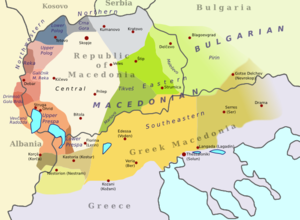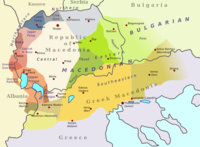
The dialects of Macedonian comprise the Slavic dialects spoken in the Republic of North Macedonia as well as some varieties spoken in the wider geographic region of Macedonia. They are part of the dialect continuum of South Slavic languages that joins Macedonian with Bulgarian to the east and Torlakian to the north into the group of the Eastern South Slavic languages. The precise delimitation between these languages is fleeting and controversial.
Classification
Macedonian authors tend to treat all dialects spoken in the geographical region of Macedonia as Macedonian, including those spoken in the westernmost part of Bulgaria (so-called Pirin Macedonia), whereas Bulgarian authors treat all Macedonian dialects as part of the Bulgarian language. Prior to the codification of standard Macedonian in 1945, the dialects of Macedonia were for the most part classified as Bulgarian. In Greece, the identification of the dialects spoken by the local Slavophone minority with either Bulgarian or Macedonian is often avoided, and these dialects are instead described simply as "Slavic", Dopia ('Local'), Stariski (old) or Našinski (ours).
Most Western linguists classify the dialects in the Pirin (Blagoevgrad) region of Bulgaria and in the far east of Greek Macedonia as Bulgarian and the dialects in the rest of Greece and in Republic of North Macedonia as Macedonian. According to Chambers and Trudgill, the question whether Bulgarian and Macedonian are distinct languages or dialects of a single language as well as where the exact boundary between the two languages is cannot be resolved on a purely linguistic basis, but should rather take into account sociolinguistic criteria, i.e., ethnic and linguistic identity. As for the Slavic dialects of Greece, Trudgill classifies the dialects in the east Greek Macedonia as part of the Bulgarian language area and the rest as Macedonian dialects.
According to Riki van Boeschoten, the dialects in eastern Greek Macedonia (around Serres and Drama) are closest to Bulgarian, those in western Greek Macedonia (around Florina and Kastoria) are closest to Macedonian, while those in the centre (Edessa and Salonica) are intermediate between the two. Jouko Lindstedt also opines that the dividing line between Macedonian and Bulgarian should be defined by the linguistic identity of the speakers, i.e., by the state border:
Macedonian dialectology... considers the dialects of south-western Bulgaria to be Macedonian, despite the lack of any widespread Macedonian national consciousness in that area. The standard map is provided by Vidoeski. It would be futile to tell an ordinary citizen of the Macedonian capital, Skopje, that they do not realise that they are actually speaking Bulgarian. It would be equally pointless to tell citizens of the southwestern Bulgarian town of Blagoevgrad that they (or at least their compatriots in the surrounding countryside) do not ‘really’ speak Bulgarian, but Macedonian. In other words, regardless of the structural and linguistic arguments put forth by a majority of Bulgarian dialectologists, as well as by their Macedonian counterparts, they are ignoring one, essential fact – that the present linguistic identities of the speakers themselves in various regions do not always correspond to the prevailing nationalist discourses.
Linguistically, the dialects of Macedonia in the wider sense can be divided into Eastern and Western groups (the boundary runs approximately from Skopje and Skopska Crna Gora along the rivers Vardar and Crna) based on a large group of features. In addition, a more detailed classification can be based on the modern reflexes of the Proto-Slavic reduced vowels ("yers"), vocalic sonorants and the back nasal (o). That classification distinguishes between the following 3 major groups:
Dialects
- Macedonian
- Northern dialects
- Western group:
- Eastern group:
- Western Dialects:
- Central group:
- Western and north western group:
- Eastern and Southern dialects
- Eastern group:
- South-western group:
- South-eastern group:
- Northern dialects
The Ser-Drama-Lagadin-Nevrokop dialect and the Bulgarian part of the Maleševo-Pirin dialect are classified as Bulgarian by modern Western linguists. The classification of the dialects of central Greek Macedonia is more unclear, with some linguists classifying them as Macedonian and others as transitional between Macedonian and Bulgarian.
Variation in consonants


As far as consonantal features are concerned, the entire Western region is distinguished from the East by loss of /x/ (except Tetovo, Gora and Korča) and the loss of /v/ in the intervocalic position (except Mala Reka and parts of Kostur-Korča): /ɡlava/ (head) = /ɡla/, /ɡlavi/ (heads) = /ɡlaj/. The Eastern region preserves /x/ (except Tikveš-Mariovo and Kumanovo-Kriva Palanka) and intervocalic /v/. The East is also characterised by the development of epenthetic /v/ before original /o/ where the West has epenthetic /j/: Eastern /vaɡlɛn/ (coal) but Western /jaɡlɛn/. The diphonemic reflexes are most characteristic of the dialects of Greek Macedonia and Blagoevgrad Province, Kostur-Korča and Ohrid-Prespa. The Serres – Nevrokop dialects have a series of phonemically palatalised consonants.
Variation in word stress and its effects on vowels
The Western dialects generally have fixed stress, antepenultimate in the Republic of North Macedonia, and penultimate in Greece and Albania. The Eastern region, along with the neighbouring Bulgarian dialects, has various non-fixed stress systems. In Lower Vardar and Serres-Nevrokop unstressed /a, ɛ, ɔ/ are reduced (raised) to . The reduction of unstressed vowels (as well as the aforementioned allophonic palatalisation of consonants) is characteristic of East Bulgarian as opposed to West Bulgarian dialects, so these dialects are regarded by Bulgarian linguists as transitional between East and West Bulgarian.
External links
- Digital resources of Macedonian dialects
- Audio recordings, examples from the collection of Bozhidar Vidoeski — Center for areal linguistics - MANU
- Map of Macedonian dialects with sample texts and audio recordings — Center for areal linguistics - MANU
References
- isp. Большaя Советская Энциклопедия, tom. 37, Moscow 1938, р 743–744
- Institute of Bulgarian Language (1978). Единството на българския език в миналото и днес (in Bulgarian). Sofia: Bulgarian Academy of Sciences. p. 4. OCLC 6430481.
- Стойков (Stoykov), Стойко (2002) . Българска диалектология (Bulgarian dialectology) (in Bulgarian). София: Акад. изд. "Проф. Марин Дринов". ISBN 954-430-846-6. OCLC 53429452. Archived from the original on 2010-05-27. Retrieved 2008-09-30.
- Mazon, Andre. Contes Slaves de la Macédoine Sud-Occidentale: Etude linguistique; textes et traduction; Notes de Folklore, Paris 1923, p. 4.
- Селищев, Афанасий. Избранные труды, Москва 1968.
- K. Sandfeld, Balkanfilologien (Copenhagen, 1926, MCMXXVI).
- Macedonian at Ethnologue (25th ed., 2022)

- ^ Trudgill P., 2000, "Greece and European Turkey: From Religious to Linguistic Identity". In: Stephen Barbour and Cathie Carmichael (eds.), Language and Nationalism in Europe, Oxford : Oxford University Press, p.259.
- Schmieger, R. 1998. "The Situation of the Macedonian Language in Greece: Sociolinguistic Analysis", International Journal of the Sociology of Language 131, 125–55.
- Chambers, Jack; Trudgill, Peter (1998). Dialectology (2nd ed.). Cambridge University Press. pp. 7.
Similarly, Bulgarian politicians often argue that Macedonian is simply a dialect of Bulgarian – which is really a way of saying, of course, that they feel Macedonia ought to be part of Bulgaria. From a purely linguistic point of view, however, such arguments are not resolvable, since dialect continua admit of more-or-less but not either-or judgements.
- ^ Boeschoten, Riki van (1993). Minority Languages in Northern Greece. Study Visit to Florina, Aridea, (Report to the European Commission, Brussels).
The Western dialect is used in Florina and Kastoria and is closest to the language used north of the border, the Eastern dialect is used in the areas of Serres and Drama and is closest to Bulgarian, the Central dialect is used in the area between Edessa and Salonica and forms an intermediate dialect
- Ioannidou, Alexandra (1999). Questions on the Slavic Dialects of Greek Macedonia. Athens: Peterlang. pp. 59, 63. ISBN 9783631350652. Archived from the original on 2023-04-28. Retrieved 2023-05-10.
{{cite book}}:|journal=ignored (help) - Lindstedt, Jouko (2016). "Conflicting Nationalist Discourses in the Balkan Slavic Language Area". The Palgrave Handbook of Slavic Languages, Identities and Borders. pp. 429–447. doi:10.1007/978-1-137-34839-5_21. ISBN 978-1-349-57703-3. Archived from the original on 2023-06-20. Retrieved 2023-05-10.
- Tomasz Kamusella, Motoki Nomachi, Catherine Gibson as ed., The Palgrave Handbook of Slavic Languages, Identities and Borders, Springer, 2016; ISBN 1137348399, p. 436.
- стр. 244 Македонски јазик за средното образование- Стојка Бојковска, Димитар Пандев, Лилјана Минова-Ѓуркова, Живко Цветковски- Просветно дело- Скопје 2001
- Z. Topolińska – B. Vidoeski, Polski~macedonski- gramatyka konfrontatiwna, z.1, PAN, 1984
- стр.68 Граматика на македонскиот литературен јазик, Блаже Конески, Култура- Скопје 1967
- Академик Божидар видоески, Кичевскиот говор. МЈ, 1957, VIII, 1, стр. 31–90.
- Belić 1935: A. Belić, Galički dijalekat, Srpski dijalektološki zbornik, VII, Srpska kraljevska akademija, Belgrade – Sr. Karlovci, 1-352+IV
- The Radožda-Vevčani Dialect of Macedonian: Structure, Texts, Lexicon by P. Hendriks. The Slavic and East European Journal, Vol. 22, No. 1 (Spring, 1978), pp. 111–112
- A Comparative Historical Analysis of Nominal Accentuation in Archaic (Maleševo) and Transitional (Nivičino) Eastern Macedonian Dialects," in Proceedings of the Third North American-Macedonian Conference on Macedonian Studies. Indiana Slavic Studies 10:135–151. 1999
- Македонските дијалекти во Егејска Македонија: (Обид за класификација). Македонските дијалекти во Егејска Македонија: научен собир, Скопје 23–24 декември 1991. Скопје: МАНУ, 1994, стр. 23–60.
- ^ str. 249- 252 Makedonski jazik za srednoto obrazovanie- S. Bojkovska, D. Pandev, L. Minova-Ǵurkova, Ž.Cvetkovski- Prosvetno delo AD- Skopje 2001
- Schmieger, R. 1998. "The Situation of the Macedonian Language in Greece: Sociolinguistic Analysis", International Journal of the Sociology of Language 131, 125–55.
| Macedonian language (македонски јазик) | ||
|---|---|---|
| Features |  | |
| Dialects | ||
| Other topics | ||
| Dialects of Macedonian | ||||||
|---|---|---|---|---|---|---|
| Western |
|  | ||||
| Northern |
| |||||
| Southeastern |
| |||||
| Also considered a dialect of Bulgarian. Considered to be a part of the transitional Torlak dialect and as a subdialect of Bulgarian, Macedonian, and Serbo-Croatian. | ||||||